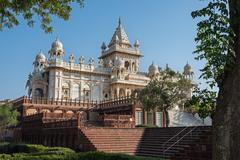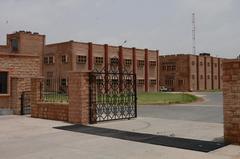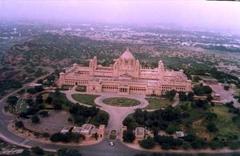Defence Laboratory Jodhpur Visiting Hours, Tickets, and Travel Guide
Date: 04/07/2025
Introduction
Defence Laboratory Jodhpur (DLJ), located in the vibrant city of Jodhpur, Rajasthan, is a cornerstone of India’s defence research and development ecosystem. Since 1959, DLJ has specialized in pioneering technologies suited for desert warfare, including camouflage systems, nuclear radiation management, and desert sciences. Driven by its mandate under the Defence Research and Development Organisation (DRDO), the laboratory has propelled innovations vital to India’s military capabilities and self-reliance.
Although DLJ itself is a high-security establishment and not open to public visits, its presence and achievements are closely connected to Jodhpur’s historical legacy. Visitors interested in defence technology and history can explore nearby landmarks such as Mehrangarh Fort and Ratanada Palace, the latter holding significance as DLJ’s original base. This guide details DLJ’s contributions, visitor information, key research areas, and travel tips for those exploring Jodhpur’s defence and cultural heritage.
For authoritative background and news, refer to DRDO Historical Background and Patrika News.
Table of Contents
- Origins and Establishment
- Evolution of Research Focus
- Infrastructure and Relocation
- Contributions to National Defence
- Integration with DRDO’s Broader Mission
- Recent Developments and Achievements
- Visiting Defence Laboratory Jodhpur: What You Need to Know
- FAQ – Frequently Asked Questions
- Visuals and Media
- Mehrangarh Fort: Visitor Guide
- Summary of Key Information and Visitor Tips
- References and Useful Links
Origins and Establishment
Founded in May 1959 under DRDO, the Defence Laboratory Jodhpur was established to develop and test defence technologies specifically suited for the Thar Desert’s harsh environment. Its mandate covered field trials of weapons, research in desert sciences, radio-wave propagation, and solar energy applications, all aimed at enhancing India’s strategic readiness (DRDO Historical Background, Wikipedia: Defence Laboratory).
Evolution of Research Focus
DLJ’s research evolved from field trials and environmental adaptation to advanced domains:
- Camouflage and Deception: DLJ developed multispectral camouflage, including adaptive coatings and stickers for military vehicles, tested successfully on T-90 tanks (Patrika News, The Defence News).
- Nuclear Radiation Management: Creation of indigenous monitoring and detection systems to address nuclear contingencies (Wikipedia: Defence Laboratory).
- Desert Sciences: Solutions for water management, heat mitigation, and terrain adaptation for military operations (DRDO Area of Work).
- Electronics and Communications: Development of secure communication systems including data links, satellite communication, and millimeter-wave systems (En-Academic).
Infrastructure and Relocation
Originally based in Ratanada Palace, DLJ later moved to a modern technical complex in Jodhpur to accommodate its expanding scope. Ratanada Palace now serves as a DRDO training center (Wikipedia: Defence Laboratory).
Contributions to National Defence
DLJ’s innovations have enhanced India’s defence posture:
- Adaptive Camouflage: Adopted for Indian Army vehicles, tested on T-90 tanks for stealth against surveillance (Patrika News).
- Microwave Obscurant Chaff (MOC): Transferred to Indian Navy, reducing radar signature of naval assets (Wikipedia: Defence Laboratory).
- Industry Collaboration: Enabled indigenous production of critical defence components such as chaff payloads (Wikipedia: Defence Laboratory).
Integration with DRDO’s Broader Mission
DLJ is part of DRDO’s network of over 50 laboratories, contributing to self-reliance and operational effectiveness for India’s armed forces (Wikipedia: DRDO). Its work includes:
- Operational research and environmental adaptation
- Potable water and quality management
- Transportation and navigation systems for desert terrains (DRDO Historical Background)
Recent Developments and Achievements
- Virtual Reality Applications: Innovations for naval ship training (Ajai Shukla Blog).
- Patents and Technology Transfer: Over 201 patents granted in 2024, with significant industry collaboration (Ajai Shukla Blog).
- Academic Engagement: Active collaboration with academic institutions for defence research (Ajai Shukla Blog).
Visiting Defence Laboratory Jodhpur: What You Need to Know
Public Access:
DLJ is a high-security site and does not offer public tours or ticketed visits. Recruitment candidates, official delegations, and academic collaborators may visit by prior arrangement only. There are no general visiting hours.
How to Engage:
- Recruitment: DLJ conducts walk-in interviews for Research Associate (RA) and Junior Research Fellow (JRF) positions, announced on official DRDO and government portals (sarkarinaukrifront.com).
- Public Exhibitions: Occasionally participates in defence expos and science fairs for public engagement.
Nearby Attractions for Defence and History Enthusiasts:
- Mehrangarh Fort: A 15th-century fort with panoramic views and a renowned museum.
- Ratanada Palace: DLJ’s original base, now a DRDO training center.
- Jaswant Thada: Marble cenotaph with gardens near Mehrangarh.
Travel Tips:
- Jodhpur is accessible by air, rail, and road.
- The best time to visit is October to March.
- Local guides can provide military and heritage-focused tours.
FAQ – Frequently Asked Questions
Q1: Can the public visit Defence Laboratory Jodhpur?
A: No, DLJ is not open to the public.
Q2: Are there guided tours or public events at DLJ?
A: No public tours or events are held due to security protocols.
Q3: How can I apply for research positions at DLJ?
A: Recruitment is announced on DRDO’s official website and related portals.
Q4: Is photography allowed inside the laboratory?
A: No, photography is strictly prohibited.
Visuals and Media
Explore official images of DLJ’s Ratanada Palace, Mehrangarh Fort, and Jodhpur’s landscape for context. Virtual maps and online tours of nearby sites are recommended for planning.
Mehrangarh Fort: Visitor Guide
History and Significance
Mehrangarh Fort, built in 1459 by Rao Jodha, is a symbol of Rajasthan’s royal heritage. It houses palaces like Moti Mahal and Phool Mahal, and a museum with artifacts reflecting Marwar’s history.
Visiting Hours and Tickets
- Hours: 9:00 AM – 5:00 PM daily
- Tickets: Indian Adults ₹100, Foreign Adults ₹500, Children under 15 free, Camera fee ₹100
Tickets available online or at the entrance (Mehrangarh Fort Official Website).
Accessibility and Amenities
- Guided and audio tours available
- Partial wheelchair access
- Souvenir shops, cafés, restrooms
Tips
- Visit October–March for pleasant weather
- Wear comfortable shoes
- Photography allowed except for drones
Nearby Attractions
- Umaid Bhawan Palace
- Jaswant Thada
- Clock Tower Market
- Rao Jodha Desert Rock Park
Summary of Key Information and Visitor Tips for Defence Laboratory Jodhpur
References and Useful Links for Defence Laboratory Jodhpur Visitors
- DRDO Historical Background
- Patrika News
- The Defence News
- MySarkariNaukri: DLJ Overview
- Wikipedia: DRDO
- Wikipedia: Defence Laboratory
- Ajai Shukla Blog
- SarkariNaukriFront: DRDO JRF/RA Recruitment
- iadb.in
- Defence Direct Education
- Mehrangarh Fort Official Website


